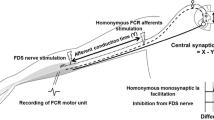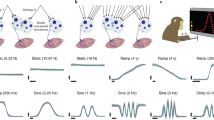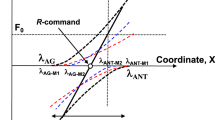Summary
Reflex responses are “servo-like” where the output is graded with the input or are “triggered” where the output is independent of input once an input threshold is exceeded. Imposed displacements of monkey or human upper limb joints result in prolonged EMG output in the muscles stretched by the displacements. The longer-latency portions of the prolonged output have been variously reported to be servo-like or to be triggered in nature.
In monkeys and humans, angular wrist displacements imposed by step loads result in three peaks (M1, M2 and M3) in the gross EMG recorded from the stretched muscles. Each gross EMG peak largely results from the firing of a separately-responding subpopulation of single motor units (SMUs). We studied the responses of SMUs to loads that were presented to the monkeys in a random order as to magnitude, duration and onset time. Average response histograms were constructed for the SMU responses for individual step load magnitudes. Averages were also constructed for the simultaneously-recorded gross EMG responses for each step load magnitude. The input parameters used were the initial velocity of displacement or the magnitude of step load, while the output was taken as the probability of firing/millisecond/presentation above baseline for the SMUs or the area under the response peaks above baseline for gross EMG. The results establish:
-
1)
That it is not possible to unambiguously determine the input-output properties of the responses to imposed displacements utilizing the analysis of gross EMG activity due to the response characteristics of the various subpopulations of motor units contributing to the gross response.
-
2)
That the SMU activity during all of the peak intervals is monotonically graded with increases in magnitude of the step load or the initial velocity of displacement. Hence, the long-latency portions of the EMG responses are servo-like in nature and are not preprogrammed or triggered responses.
-
3)
That the gain (output/input) of the gross EMG responses almost entirely reflects the variation in the number of motoneurons recruited by changes in magnitude of the step loads rather than variation in the firing rates of motoneurons during the reflex responses.
Similar content being viewed by others
References
Allum, J.H.J.: Responses to load disturbances in human shoulder muscles: The hypothesis that one component is a pulse test information signal. Exp. Brain Res. 22, 307–326 (1975)
Bawa, P., Tatton, W.G.: Motor unit responses to angular wrist displacements in monkey and man. Can. Physiol. 8, 27 (1977)
Bawa, P., Tatton, W.G.: Motor units responses in muscles stretched by imposed displacements of the monkey wrist. Exp. Brain Res. 37, 417–437 (1979)
Bizzi, E., Evarts, E.V.: Translational mechanisms between input and output. Neurosci. Res. Bull. 6, 31–59 (1971)
Burke, R.E.: A comment on the existence of motor unit ‘types’. In: The nervous system. Tower, D.G. (ed.). Vol. 1. The basic neurosciences, pp. 611–619. New York: Raven Press 1975
Chan, C.W.Y., Melvill-Jones, G., Catchlove, R.F. H.: Do muscle afferents contribute to long-loop reflexes in man? DRB Aviat. Med. Res. Unit Rep. 3, 223–230 (1973)
Cooke, J.D., Eastman, M.J.: Long-loop reflexes in the tranquilized monkey. Exp. Brain Res. 27, 491–500 (1977)
Crago, P.E., Houk, J.C., Hasan, A.: Regulatory actions of human stretch reflex. J. Neurophysiol. 39, 925–935 (1976)
Fields, H.L.: Proprioceptive control of posture in the crayfish abdomen. J. Exp. Biol. 44, 455–468 (1966)
Hammond, P.H.: Involuntary activity in biceps following the sudden application of velocity to the abducted forearm. J. Physiol. (Lond.) 127, 23–25 (1954)
Henneman, E., Somjen, G., Carpenter, D.O.: Functional significance of cell size in spinal motoneurons. J. Neurophysiol. 28, 560–580 (1965a)
Henneman, E., Olson, C.B.: Relations between structure and function in the design of skeletal muscles. J. Neurophysiol. 28, 581–598 (1965b)
Henneman, E., Somjen, G., Carpenter, D.O.: Excitability and inhibitibility of motoneurons of different sizes. J. Neurophysiol. 28, 599–620 (1965c)
Henneman, E., Clamann, H.P., Gillies, J.D., Skinner, R.D.: Rank order of motoneurons within a pool: Law of combinations. J. Neurophysiol. 37, 1328–1337 (1974)
Houk, J.C., Henneman, E.: Responses of Golgi tendon organs to active contractions of soleus muscle of cat. J. Neurophysiol. 30, 466–481 (1967)
Lee, R.G., Tatton, W.G.: Motor responses to sudden limb displacements in primates with specific CNS lesions and in human patients with motor system disorders. Can. J. Neurol. Sci. 2, 285–292 (1975)
Lee, R.G., Tatton, W.G.: Long-loop reflexes in humans: Clinical application. In: Progress in clinical neurophysiology, Desmedt, J.E. (ed.), Vol. 4, pp. 320–333. Basel: Karger 1978
Marsden, C.D., Merton, P.A., Morton, H.B.: Servo action in human voluntary movement. Nature 238, 140–143 (1972)
Marsden, C.D., Merton, P.A., Morton, H.B.: Servo action in human muscles. In: International Symposium on human reflexes and motor disorders, Desmedt, J.E. (ded.), pp. 123–124. Brussels 1976a
Marsden, C.D., Merton, P.A., Morton, H.B.: Stretch reflex and servo action in a variety of human muscles. J. Physiol. (Lond.) 259, 531–560 (1976b)
Matthews, P.B.C.: Mammalian muscle receptors and their central action. London: Arnold 1972
Meier-Ewert, K., Humme, U., Dahm, J.: New evidence favouring long-loop reflexes in man. Arch. Psychiat. Nervenkr. 215, 121–128 (1972)
Melvill-Jones, G., Watt, D.G.D.: Observations on the control of stepping and hopping movements in man. J. Physiol. (Lond.) 219, 709–727 (1971)
Milner-Brown, H.S., Stein, R.B., Yemm, R.: Changes in firing rate of human motor units during linearly changing voluntary contractions. J. Physiol. (Lond.) 230, 371–390 (1973)
Mortimer, J. A., Johnson, M. J.: Modification in monosynaptic and long-loop reflexes by movement tasks and preloads. In: International symposium on human reflexes and motor disorders, Desmedt, J.E. (ed.), pp. 131–132. Brussels 1976
Murphy, J.T., Kwan, H.C., MacKay, W.A., Wong, Y.C.: Physiological basis of cerebellar dysmetria. Can. J. Neurol. Sci. 2, 279–284 (1975)
Oguztorelli, M.N., Stein, R.B.: The effects of multiple reflex pathways on the oscillations in neuro-muscular systems. J. Math. Biol. 3, 87–101 (1976)
Phillips, C.G.: Motor apparatus of the baboon's hand. Proc. Roy. Soc. B. 173, 141–174 (1969)
Stephens, J.A., Usherwood, T.P., Garnett, R.: Technique for studying synaptic connections of single motoneurons in man. Nature 263, 343 (1976)
Tatton, W.G., Bawa, P., Bruce, I.C., Lee, R.G.: Long-loop reflexes in monkeys: An interpretative base for human reflexes. In: Progress in clinical neurophysiology, Desmedt, J.E. (ed.), Vol. 4, pp. 229–245. Basel: Karger 1978
Tatton, W.G., Forner, S.D., Gerstein, G.L., Chambers, W.W., Liu, E.N.: The effect of post-central cortical lesions on motor responses to sudden upper limb displacements in monkeys. Brain Res. 96, 108–113 (1975)
Author information
Authors and Affiliations
Additional information
Present address: Department of Kinesiology, Simon Fraser University, Burnaby, B.C., Canada, V5A 1S6
Rights and permissions
About this article
Cite this article
Tatton, W.G., Bawa, P. Input-output properties of motor unit responses in muscles stretched by imposed displacements of the monkey wrist. Exp Brain Res 37, 439–457 (1979). https://doi.org/10.1007/BF00236816
Received:
Issue Date:
DOI: https://doi.org/10.1007/BF00236816




